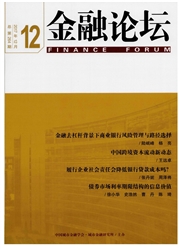

 中文摘要:
中文摘要:
本文在对国内商业银行流动性风险形成机制进行分析的基础上,选取10个流动性监管指标,采用方差最大化组合赋权评价方法,对14家商业银行的流动性风险水平进行了综合评价及排序。结果显示:从总体上看,中国商业银行流动性管理较好,大部分商业银行流动性风险水平处于适中区域。招商银行和华夏银行流动性风险水平偏高,需要加以防范;四大商业银行流动性风险水平适中,经营状况良好;深圳发展银行和浦东发展银行流动性风险水平较低,经营非常稳健。部分商业银行拆入资金比率和贷款存款比率升高等给流动性管理带来了较大难度。
 英文摘要:
英文摘要:
Based on the analysis of the formation mechanism of the liquidity risks of domestic commercial banks, this paper selects 10 indicators of liquidity supervision and uses the method of the Combination Weighting of Maximizing Deviations to e- valuate and rank the levels of the liquidity risks of 14 national commercial banks. The results show that, overall, the liquidity management of Chinese commercial banks is good and the liquidity risks of the most commercial banks are at the moderate lev- el. However, the levels of the liquidity risks of CMBC and HXB are high and need to be controlled; those of the big four com- mercial banks are moderate and the four banks operate in good condition; the liquidity risks of SDB and SPDB are at low levels and the operation of the banks is very stable. That the ratio of the borrowed capital and the ratio of loan to deposit in some of commercial banks rise makes the liquidity management difficulty.
 同期刊论文项目
同期刊论文项目
 同项目期刊论文
同项目期刊论文
 Financial relationships, banking structure and financing constraints: evidence from private enterpri
Financial relationships, banking structure and financing constraints: evidence from private enterpri 期刊信息
期刊信息
